Dell U3014 LCD Review
by Chris Heinonen on April 15, 2013 2:00 PM ESTAnother reason that we changed calibration packages is that we can now target AdobeRGB correctly, as CalMAN supports it and almost any other color space out there. Here we used the U3014 AdobeRGB preset and measured with the same targets as before. We didn’t do the 80 cd/m2 pass as AdobeRGB doesn’t use an sRGB gamma curve in the specification, and we saw how the Dell U3014 handles the change in luminance levels already. We are mostly looking to see how the monitor handles the larger gamut of AdobeRGB and if it gets the color points correct.
Once again, the Grayscale has a green bias to it by default. The overall average CCT looks good at 6568K, but that’s why you have to look at the individual RGB components as you can easily have an accurate CCT but have a color shift that is clearly visible.
The gamma is once again very good up until 85-90% where we see a steep drop-off that seems to be crushing highlights a bit. This issue pushes the average gamma down to 2.1 from our 2.2 target. I checked the contrast with a pattern before setting it and taking the measurements so all white samples are visible, but it seems to push them too close together at the top. I’d recommend taking the contrast down 3-4 levels from the maximum available to help with this highlight clipping, but that also will reduce the contrast ratio a bit as we saw with the sRGB calibration.

The grayscale starts out good, but you get errors above a dE2000 of 5 from 35% on, except for at 85%. Given the green tint that we saw in the RGB balance this isn’t surprising at all, since dE2000 is really a combination of gamma and RGB balance, and if both of those are perfect your dE2000 should be perfect as well. Conversely, when there are errors (as seen above), they'll show up here as well.
Colors again are very good by default, with errors being made much worse by the presence of white in the average. You can see the much larger gamut of AdobeRGB here, as those color points are in different locations than they are with sRGB. The color dE2000 errors are on top, and on bottom is the AdobeRGB CIE chart with the sRGB CIE chart overlaid on it to show the difference in gamut size.
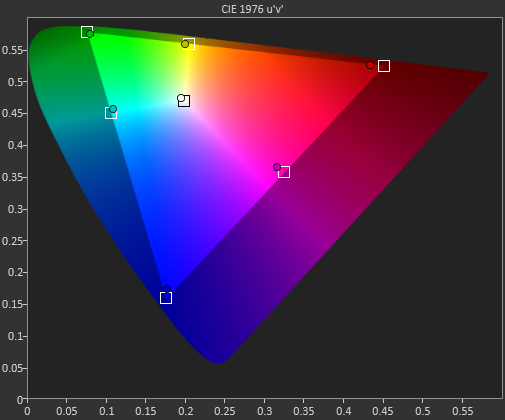
The Gretag chart fares worst in the default AdobeRGB mode, with the grayscale being a very high error and skin tones being bad as well. Most other colors manage to get to a dE2000 of 3.0 or below, but the average for the whole chart is 3.22, which is still good for no calibration but not excellent. Luminance levels for the colors are all still fantastic, which is the most important thing to get right, but other aspects of the colors don’t fare as well.
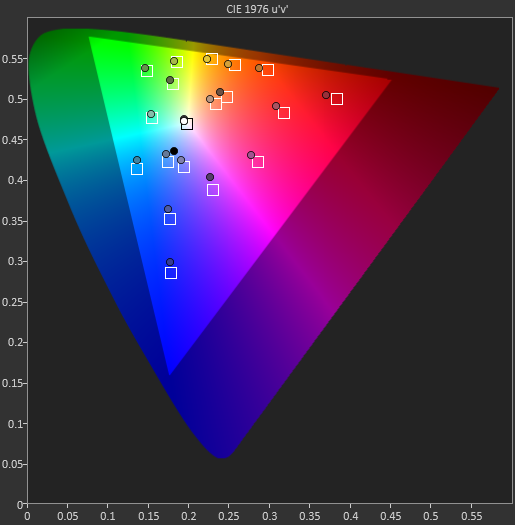
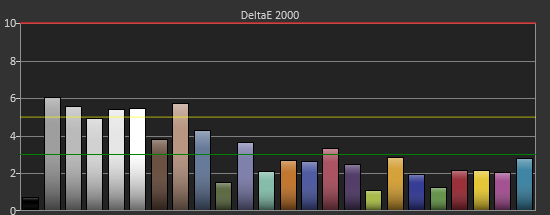

Finally our saturations show that we have errors that get larger the closer we get to being unsaturated. Despite the higher errors there, our eyes are really more sensitive to errors with 100% saturation, so it’s better that the errors happen this way than the opposite way. Of course, this should improve after calibration, and then we hopefully won’t have to make any sacrifices at all.
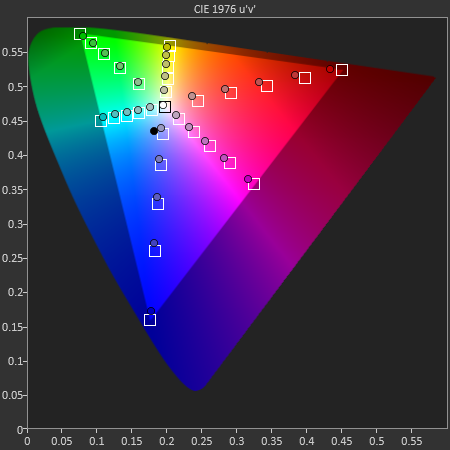
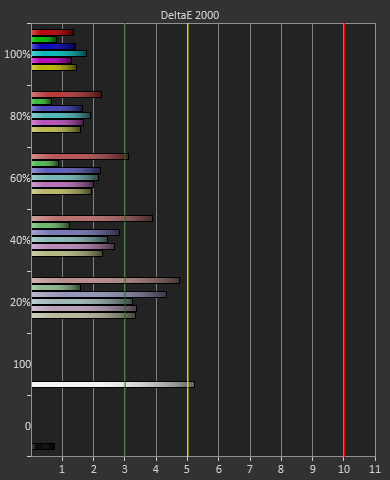


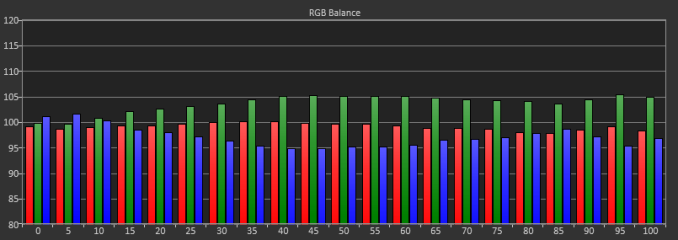
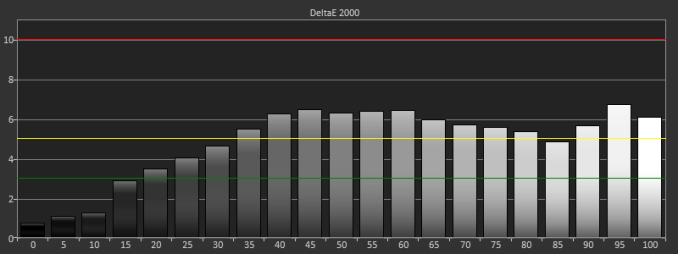










84 Comments
View All Comments
zer0future - Monday, April 15, 2013 - link
Would you guys be able to review the new monitors from Monoprice.com? Here is the link for anyone interested.http://www.monoprice.com/products/subdepartment.as...
The 27 inch model apparently uses the same panel as the apple cinema display. These prices are also quite competitive so they have me interested.
cheinonen - Tuesday, April 16, 2013 - link
I'm talking to them, though I personally think the 30" would make for a more interesting review as we've covered a lot of the 27" IPS panels now. Also, if you look back at the two LG 29EA93 reviews that I did, you can see that the panel only makes up a small part of the performance of a display. The corresponding electronics are a huge factor in performance, so I don't recommend just looking at the panel to determine the performance.Trefugl - Tuesday, April 16, 2013 - link
It is great to hear that you are in talks with Monoprice! I would be grateful for a review of either model, but would be more interested in the one with an OSD. I'm concerned with having a wide gamut screen that has no sRGB mode or color correction on board, tho the potentially reduced input lag of not having processing is alluring as well.cheinonen - Thursday, April 18, 2013 - link
I don't believe any of the Monoprice displays are wide gamut, only sRGB gamut. It looks like the 30" one has a 10-bit panel, but that's certainly 8-bit with AFRC, which might give you better gradients, but won't give you a wider gamut.B3an - Tuesday, April 16, 2013 - link
Chris, i'd really appreciate it if you could help me as i'm thinking of buying this monitor. Do you have any idea at all if the i1Display 2 will calibrate this monitor well? It comes with Eye-One Match 3 software.And what software would you recommend most for calibration? dispcalGUI?
cheinonen - Tuesday, April 16, 2013 - link
Personally, I wouldn't use an i1Display2 anymore for color accuracy. With the design of the i1Display2, and the fact that they haven't been made for a year or two now, the filters degrade over time so that anything it is reading now may or may not be accurate at all. It can read light levels correctly, so white and black light output, but not the colors of light. I have a pair of them here and testing them now compared to the i1Pro, I see dE2000 errors > 10 in the grayscale using it. The standard calibrated modes are going to likely be more accurate.I like dispcalGUI. I haven't used the most recent version, but I've been using it for a long time now and they do a great job adding more and more features to it.
von Krupp - Tuesday, April 16, 2013 - link
You know what's missing from this monitor? Support for 5.1 output like its out-going predecessor. I make great use of that feature on my U2711, and not having it here is a major deal-breaker. I run my Xbox 360 to the monitor via HDMI and pipe the audio out through the analogue 5.1 jacks to Logitech X-530s. I would not be able to do that with these new monitors.I might be a hold-out, but one of the primary selling points for me on the U3011 and U2711 was the fact that, for a PC monitor, they offered a diverse array connectivity. You can do HDMI, composite, component, DVI, VGA, and DP all on the same monitor. You can also, as mentioned, earlier, output to analogue 5.1 surround. This monitor is not worth the $1500 asking price in light of this "streamlining" of features. If I'm paying top-dollar for a monitor whose predecessor I already own, I want it to have all of the capabilities of that predecessor and then some. $1500 for what is only a good panel and LED back-lighting is a raw deal no matter how you slice it.
jamyryals - Tuesday, April 16, 2013 - link
Chris, my coworker has a Nixeus 27inch monitor attached to a 2012 MBP. His Nixeus has the same problem of not activating after sleep sometimes as well. A simple power cycle gets it going again for him too. Just another data point to indicate where that particular problem may be.l_d_allan - Tuesday, April 16, 2013 - link
The 2010 and 2011 models are coming down in price nicely. I just ordered a U2410 that should be a significant upgrade from my current Samsung TN panel that only has about 70% of sRGB.The only significant difference I'm aware of to the U2413 is the hardware calibration capability, but I have a Spyder rather than X-Rite, so my understanding is that is a non-issue. YMMV.
cheinonen - Tuesday, April 16, 2013 - link
The U2410 is a CCFL backlight and the U2413 utilizes the G-B LED backlight that the U3014 uses. It also has the MiniDP and DisplayPort inputs and a DisplayPort output for using MST, and USB 3.0 over 2.0. It loses the analog inputs that the U2410 has, so if you have a need for those it is certainly the one to use. Since you're using a Spyder, the calibration software is a non-issue.